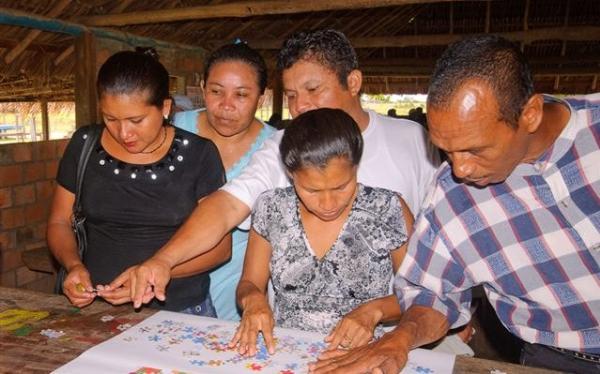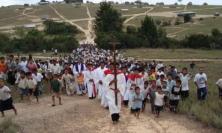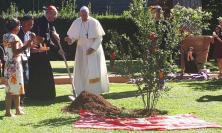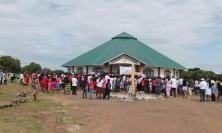To the people of the village of Aishalton in the Guyanese Interior, the political activity in most of the world’s democratic countries would seem far removed from their everyday lives. But over the past year, the villagers have been taking part in a process at the very heart of which is the concept of participatory democracy. Sarah Broscombe describes the stages and outcomes of the Community Development Plan, and the importance of involving Guyana’s indigenous population in the country’s political life.
Despite 2500 years of practice, the world still struggles to sustain a democracy that is satisfyingly representative. Anyone observing the political activity of most democratic countries in an election year could be forgiven for believing ‘democracy’ to be synonymous with ‘voting’; as if it simply consists in according a certain political party the right to make decisions for you. Truly participatory democracy is deeply demanding of politicians and electorate alike, and few states are brave enough to attempt it. With its highly unusual racial mix, Guyana makes a fascinating study of what happens when a 21st century state attempts to keep several types of democratic process in play simultaneously.
In 2011, the democratic republic of Guyana will hold both regional and national elections. For the 90% of the Guyanese population who live in the narrow coastal strip, these elections will take place according to a political model that would look familiar to most Europeans: general and local elections, a multi-party system, executive and legislative power separated from the judiciary and so on. The elections will be preceded by the inescapable furore in the press, the inevitable mudslinging and, in Guyana’s case, they take their place in a difficult and complex history of problematic elections dating back to its Independence in 1966. With the population voting increasingly along racial lines, and migration resulting in more Guyanese living outside Guyana than in and losing their right to vote, next year’s elections are likely to maintain the status quo unless swing voters are mobilised in a way hitherto unheard of in an independent Guyana.
This is where Amerindians come in. For the 7% of Guyana’s indigenous population scattered through its huge Interior, the democratic process functions very differently. These Amerindians, who populate 95% of Guyana’s land, are entitled to vote in national elections, but for daily affairs, each village is self-governing within the bounds of the constitution and under the provisions of the Amerindian Act of 2005.
Every three years, a new Toshao (village leader) and Village Council are elected. Many villages have the title to their land in perpetuity. The Village Council has the right to establish rules and even laws for their community, allocate the right to vote, determine intellectual property, raise taxes, and give or withhold rights to run small-scale mining, forestry and other traditional land use activities. The Ministry of Amerindian Affairs states that the Act ‘transfers power from the Government to Amerindian Communities and Village Councils so that Amerindians can make their own decisions about how they want to develop’ (emphasis added). One country; two systems, where the division of systems follows racial lines, although these are in practice also geographical.
But what do the villages actually take decisions about? What does self-determination mean to them? Historically, Amerindians in Guyana have been the recipients of change, not the initiators. They have borne the consequences of land grabs, colonisation and resource plunder by disappearing, retreating, or minding their own business. There are several tangible effects of this history: placidity in the face of change, a suspicion of outsiders (and in my experience here that means all non-Amerindians, Guyanese as well as foreign) and an unspoken but strong mistrust of strategising. Up until the present, with a few notable individual exceptions, Amerindians have been largely uninvolved with national politics.
This is a population that is unused to future planning in any form. Except at the height of the rainy season, it is impossible to tell what time of year it is. The sun rises and sets at almost the same time every day. The temperature variation throughout the whole year is almost exactly the same as the temperature variation each day: 9 degrees, give or take. There is no culture of growing extra in your farm so that you have some left over to sell. More than 90% of villagers have never had formal employment. In a setting where there are almost no jobs to be had, what is the point in planning for the future? What happens will happen. Traditionally this is not a cash economy, although there are very few people remaining in the village who never deal in cash. But there is no bank within five hours’ travel in any direction. People spend their cash as they would eat their crop, and then find a way to make do until more appears. All of these realities actively discourage people from planning. What a European might term ‘fatalism’ here looks more like realism.
The government is encouraging villages to plan for their own development. But where does one start in such a context? Of course it is in the current administration’s interests to educate Amerindians about democratic participation in a milieu sympathetic to their own retention of power. Various tools have been offered in an attempt to foster positive development in communities in the interior. But the Community Development Planning forms distributed by the Ministry of Amerindian Affairs suffer from the drawbacks of any one-size-fits-all formula, exacerbated by a cultural gap so wide it might almost be termed a different worldview. This leaves villages in a quandary: how can they take advantage of the opportunities and funding offered in ways that are meaningful and appropriate to their own community?
In the village of Aishalton, where I have been working since early 2009, the Village Council decided to respond by creating a Community Development Plan that grew out of village realities, starting from the bottom up, with no givens at all. Aishalton lies a day and a half’s journey from Georgetown, in the equatorial savannahs south of Guyana’s rainforest and north of the Brazilian Amazon. A community of about 1200, Aishalton sees itself as a modern, 21st century Amerindian community with vulnerabilities that need to be addressed, but at the same time is proud of its Wapishana heritage. The Wapishana are the second-largest of Guyana’s nine Amerindian tribes, but as with many other indigenous groups, their language and traditional culture teeter on the brink of extinction.
As a development worker with the Jesuits, I came to Aishalton to support the community with whatever needs arose, and had been doing an eclectic range of tasks including fundraising, teaching, training, beginner’s music classes and making a fool of myself attempting to learn Wapishana! I was fortunate to be consulted by the Village Council right at the beginning of the community development planning process because I have a background in facilitation, and because, having lived and worked with the people of Aishalton for nearly a year, we had developed a mutual trust that is a rare privilege for an outsider here.
Instead of beginning with a proforma, we began by asking simply whether the community wanted a Development Plan at all. When this was answered with a yes (mainly based on a desire for self-determination in the face of outside influence), the next step was to identify all the constituencies existing in the village and invite at least one representative of each to participate in designing the process that would undergird the Plan. Identifying the constituencies was an education in itself: should ‘fishermen and hunters’ be one constituency or two? Does cooking flat buns on a wood fire and griddle and selling them to schoolchildren make you a ‘businessperson’? From two meetings attended by representatives of all of the constituencies in October and November 2009, a Plan design emerged with five main stages: Launch, Vision, Obstacles, Solutions and Action Planning. The Toshao elected a steering group of Village Council members and other articulate villagers, five men and five women, to run these stages.
After extensive village advertising (including some wonderful skits recorded on a laptop and broadcast via battered old stereo, boom box and diesel generator), the Launch took place in March 2010 to raise villagers’ awareness that this planning process would be utterly unlike their familiar village meetings (front-led speaker meetings, often lasting six or seven hours, with question time at the end). Amerindians in general, and Wapishana Amerindians in particular, are not generally oriented around verbal communication, so our Launch was a dynamic, two-hour activity session. The Toshao opened with a speech in Wapishana, which was followed by group art to explore the vision, puzzles and a problem tree representing obstacles, chess lessons to illustrate solutions and planning ahead, and locally made snacks as a metaphor for the good already present in the community, all accompanied by minimalist posters explaining the process in language that was as accessible as possible.
Before each of the subsequent stages, the steering group met to practice facilitating the sessions, using a consensus process that gives every participant the chance to respond in their own words, and takes those exact words forward, rather than allowing the leader to rephrase and thus control or mould the inputs. In late March, we were ready for the second stage, the Vision Day: the villagers met in small groups scattered around the various larger buildings in the village, and articulated their best realistic hopes for Aishalton’s future. Each group then sent their summary points to the steering group, who wove them into the structuring of the next stage. The Plan was thus grounded in a positive, creative vision of the future rather than defining itself by what is lacking, as so many development plans do.
In April, the resulting Obstacles session used the vision that the villagers had provided to analyse Aishalton’s current situation and clarify what obstacles were preventing the progress that villagers desired. This time the villagers chose one of three groups to attend, and once again the facilitators brought the groups’ exact words back to the full steering group. The outcomes were remarkably self-aware, critical and detailed. Fourteen key obstacles emerged, many of them from all three groups independently:
1. Disrespect, negativity and selfishness are harming the way we work together.
2. Disheartened by bad infrastructure, we don’t manage our skills and resources to the full.
3. We neglect our elders.
4. Leaders at all levels are not building trust through good example.
5. We neglect community education, and undervalue schooling.
6. Medical understaffing and our inadequate diet and hygiene are affecting health.
7. We are not taking enough responsibility for our land, water and produce.
8. We are not building pride in Wapishana culture.
9. Abuse and neglect in the family is damaging individuals.
10. Poverty is preventing some people from improving their opportunities.
11. Alcohol abuse and drunkenness are damaging families, work and community.
12. Bureaucracy and political channels block our progress.
13. Negative influences and lack of opportunities are reducing young people’s interest.
14. Religious disagreements hinder cooperation.
Comments that would be considered derogatory, negative and unwarranted attacks if made by outsiders were generated and accepted by the community in a way that allows the village to act upon them without blame and without defensiveness.
From the Obstacles, the Solutions followed naturally. By holding the vision and the obstacles together, both of which had come from the villagers themselves, the larger-scale community meeting in May, Creating Solutions, used the solid foundations already laid to identify four strategic directions that Aishalton needs to take in order to achieve its vision for itself: building strong, healthy families; developing leadership and responsibility; sustaining and strengthening cultural activities; and developing skills and creating opportunities. These strategic directions now provide guidelines for the village council over the coming five years.
The final stage in June, Action Planning, was held in the Village Council office, and attended on open invitation by anyone from the Creating Solutions session. In different senses it was both the most and the least important aspect of the Plan. One could see it as most important in the sense that it gives concrete, specific actions, both visionary and mundane, for villagers to perform in order to pursue their strategic directions – including ‘form a committee to look after our petroglyphs’; ‘establish responsibility for proper garbage disposal’, ‘start a Wapishana school for all ages’ and ‘hold video shows dealing with domestic problems’. However, one could also see it as least important because the process of the Plan was more radical than any of its outcomes. Aishalton villagers – young and old, office worker and subsistence farmer, schoolchild and village councillor – came together to throw all of their creative ideas, worries, fears and questions into a collaborative pot to simmer and mature. The dish that emerged is distinctively Aishalton; unfussy, plain, in some ways unadventurous, but packed with the nutritious and vital stuff of Wapishana life.
Aishalton is only one community in a remote corner of Guyana, but the decision-making and control that is occurring there is an example for surrounding communities of how the Amerindian Act can give communities scope to flourish. The empowerment that results from acquiring a place at college or filling in a government form correctly is important, but essentially reactive. The empowerment that comes from choosing your own questions and then answering them together, collectively, is a step for this community towards a future of their own choosing
As the electoral campaigning begins, Guyana’s two main political parties must both be keenly aware of the latent power of the Amerindian 7%. The least developed Amerindian communities are the most vulnerable to electioneering and all the manifold forms of political bribery. What must change in order for Amerindians to become more informed participants in Guyana’s wider political life, or at least make an informed choice when they vote? The most important element is trust. It is easy for cynics to sabotage government efforts in the Interior by sowing suspicions that gain plausibility through villagers’ past negative experiences of autocratic interventions. Villages even refuse to apply for land title because they are afraid of what demarcation will mean; instead of finding it empowering, they are hamstrung by their fear of being tricked. Whilst a certain level of suspicion is healthy, many communities are allowing generic distrust of outsiders to prevent them from embracing any positive change at all. Before trust can grow, mutual understanding must grow also. Outreach to schools in Amerindian areas explaining the basics of Guyanese democracy and Amerindian rights in accessible, engaging terms might be a start.
Anyone promoting development in the Interior, Guyanese or foreigner, must work at gaining a real understanding of the information void in which the vast majority of Amerindians live: ‘the information is in the public domain’ is just not a satisfactory response in areas of hundreds of square miles with no postal service, no telephones or mobiles, no mass media and no internet access, not to mention the literacy levels. Amerindians need a deep engagement with the running of their own communities before they will truly be active in the functioning and growth of Guyanese democracy as a whole. Community planning that is truly participatory is only a small step, but I believe it is a step in the right direction.
Sarah Broscombe is a development worker with the Society of Jesus in the Guyanese interior. She previously worked for the British Jesuits for seven years in the field of volunteering.
![]() Jesuit Missions
Jesuit Missions![]() Read an article by Malcolm Rodrigues SJ on the political history of Guyana
Read an article by Malcolm Rodrigues SJ on the political history of Guyana






